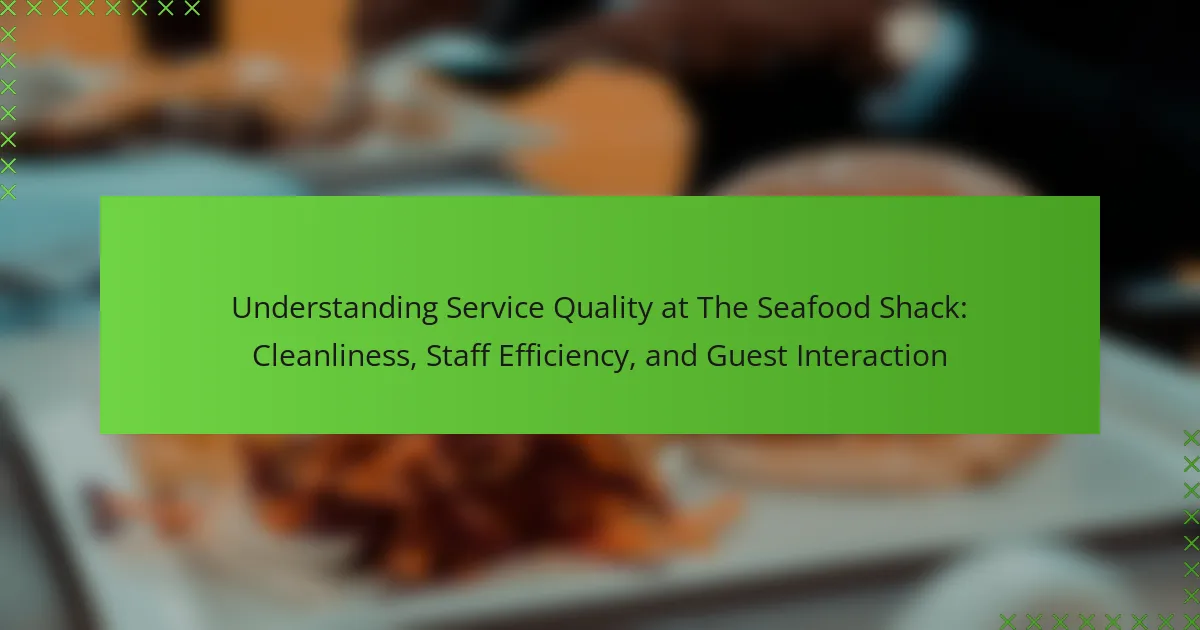
What is Service Quality at The Seafood Shack?
Service quality at The Seafood Shack refers to the overall experience customers receive during their visit. It encompasses aspects such as cleanliness, staff efficiency, and guest interaction. Cleanliness is maintained to ensure a pleasant dining environment, which is crucial for customer satisfaction. Staff efficiency is evaluated based on how quickly and accurately orders are taken and served. Guest interaction focuses on the friendliness and helpfulness of the staff. These elements together create a positive experience that encourages repeat visits and customer loyalty.
How is cleanliness defined in the context of service quality?
Cleanliness in the context of service quality refers to the state of being free from dirt, germs, and impurities. It is a critical aspect that influences customer perceptions and satisfaction. Cleanliness encompasses various areas, including dining surfaces, restrooms, and kitchen environments. High cleanliness standards contribute to a positive dining experience. Research shows that 75% of customers consider cleanliness essential when evaluating service quality. In restaurants, cleanliness directly impacts repeat business and customer recommendations. Thus, maintaining cleanliness is vital for service quality and overall business success.
What specific cleanliness standards are expected at The Seafood Shack?
The Seafood Shack expects high cleanliness standards to ensure a safe dining environment. All food preparation areas must be sanitized regularly. Surfaces should be cleaned and disinfected multiple times throughout the day. Staff are required to follow strict personal hygiene protocols. This includes frequent hand washing and wearing clean uniforms. Dining areas must be free of debris and properly set for guests. Restrooms are to be maintained in a sanitary condition at all times. These standards align with health regulations for food service establishments.
How does cleanliness impact guest satisfaction?
Cleanliness significantly impacts guest satisfaction. Guests often associate cleanliness with quality and safety. A clean environment enhances the overall dining experience. Research shows that 89% of customers consider cleanliness vital when choosing a restaurant. Dirty or unkempt spaces lead to negative perceptions. This can result in lower return rates and poor reviews. Therefore, maintaining high cleanliness standards is essential for customer retention and positive feedback.
What role does staff efficiency play in service quality?
Staff efficiency directly impacts service quality. Efficient staff members can complete tasks quickly and accurately. This leads to shorter wait times for customers. In turn, reduced wait times enhance customer satisfaction. Additionally, effective staff communication improves service delivery. Research shows that efficient service can increase customer loyalty. According to a study by the American Customer Satisfaction Index, service efficiency correlates with higher satisfaction ratings. Therefore, staff efficiency plays a crucial role in delivering high-quality service.
How is staff efficiency measured at The Seafood Shack?
Staff efficiency at The Seafood Shack is measured through several key performance indicators (KPIs). These KPIs include order accuracy, table turnover rate, and customer satisfaction scores. Order accuracy tracks how correctly staff fulfill customer requests. Table turnover rate assesses how quickly staff can serve and clear tables for new guests. Customer satisfaction scores are gathered through feedback and surveys from patrons. These metrics provide a comprehensive view of how effectively staff are performing their duties. Regular evaluations of these KPIs help identify areas for improvement and ensure a high standard of service.
What training practices enhance staff efficiency?
Effective training practices that enhance staff efficiency include targeted skills training, regular performance evaluations, and team-building exercises. Targeted skills training ensures employees possess the necessary competencies for their roles. Studies indicate that organizations implementing focused training programs see a 20% increase in productivity. Regular performance evaluations provide feedback and identify areas for improvement. This practice fosters accountability and encourages continuous development. Team-building exercises enhance collaboration and communication among staff members. Research shows that improved teamwork can lead to a 15% boost in operational efficiency. By integrating these practices, businesses can significantly enhance staff efficiency and overall service quality.
How does guest interaction influence service quality?
Guest interaction significantly influences service quality by enhancing communication and feedback. Effective guest interaction allows staff to understand guest needs and preferences. This leads to personalized service, which improves overall satisfaction. Research indicates that positive interactions can increase customer loyalty. A study by Zeithaml, Bitner, and Gremler shows that service quality is directly linked to customer perceptions of interaction. When guests feel valued, they are more likely to return. Additionally, staff can address issues promptly through direct communication. This proactive approach minimizes complaints and fosters a positive dining experience.
What types of guest interactions are prioritized at The Seafood Shack?
The Seafood Shack prioritizes personalized service and attentive communication in guest interactions. Staff members engage with guests to ensure their needs are met promptly. They also provide detailed information about menu items and specials. Additionally, staff actively seek feedback to enhance the dining experience. This approach fosters a welcoming atmosphere. It encourages repeat visits and positive word-of-mouth. The focus on interaction aligns with the establishment’s commitment to high service quality.
How do positive guest interactions affect overall service quality?
Positive guest interactions enhance overall service quality. They create a welcoming atmosphere that encourages customer satisfaction. Satisfied customers are more likely to return. They also tend to leave positive reviews, which attract new guests. Research shows that businesses with high customer satisfaction scores see increased revenue. For instance, a study by the American Express found that 70% of consumers are willing to spend more with companies that provide excellent service. Furthermore, effective communication during interactions can lead to quicker problem resolution. This efficiency improves the overall guest experience, reinforcing the importance of positive interactions in service quality.
What are the interconnections between cleanliness, staff efficiency, and guest interaction?
Cleanliness, staff efficiency, and guest interaction are interrelated components of service quality. Cleanliness directly influences guest perceptions and satisfaction. A clean environment enhances the overall dining experience. Staff efficiency affects the speed and quality of service provided to guests. Efficient staff can maintain cleanliness while attending to guest needs promptly. Positive guest interactions often stem from a clean and well-managed environment. Guests are more likely to engage positively with staff in a tidy setting. Studies show that establishments with high cleanliness ratings receive better reviews and repeat business. This creates a cycle where cleanliness and staff efficiency lead to improved guest interactions, fostering customer loyalty.
How do these elements collectively shape guest experiences?
Cleanliness, staff efficiency, and guest interaction collectively shape guest experiences by creating a welcoming and enjoyable environment. Cleanliness ensures that guests feel comfortable and safe, which is crucial for satisfaction. Staff efficiency affects the speed and quality of service, directly influencing guest perceptions of value. Positive guest interaction fosters a sense of connection and hospitality, enhancing overall enjoyment. Research shows that 70% of guests rate cleanliness as a top priority in their dining experience. Additionally, efficient service can increase customer loyalty by up to 30%. Therefore, these elements work together to enhance guest satisfaction and encourage repeat visits.
What strategies can The Seafood Shack implement to improve service quality?
The Seafood Shack can implement training programs for staff to enhance service quality. Regular training will improve staff efficiency and guest interaction. Incorporating customer feedback mechanisms can identify areas needing improvement. Establishing cleanliness protocols ensures a hygienic dining environment. Implementing technology solutions can streamline order processing and reduce wait times. Offering personalized service can enhance the guest experience. Regular performance evaluations can help maintain high service standards. These strategies are proven to elevate service quality in the restaurant industry.
What best practices can enhance cleanliness and staff efficiency?
Implementing a structured cleaning schedule enhances cleanliness and staff efficiency. This schedule should outline daily, weekly, and monthly tasks. Staff should be trained on proper cleaning techniques and the use of cleaning products. Regular audits can ensure adherence to cleanliness standards. Utilizing checklists helps staff track completed tasks. Encouraging open communication allows staff to report cleanliness issues promptly. Investing in quality cleaning equipment reduces time spent on tasks. Lastly, fostering a culture of cleanliness among staff promotes accountability and teamwork.
How can guest feedback be utilized to improve service quality?
Guest feedback can be utilized to improve service quality by identifying specific areas needing enhancement. Feedback highlights guest perceptions of cleanliness, staff efficiency, and interaction quality. Analyzing this data enables targeted training for staff, addressing identified weaknesses. Implementing changes based on feedback can lead to increased customer satisfaction. According to a study by the Cornell University School of Hotel Administration, 70% of guests are more likely to return after their feedback is acted upon. This demonstrates the direct link between feedback utilization and improved service quality.
The primary entity of the article is service quality at The Seafood Shack, which encompasses cleanliness, staff efficiency, and guest interaction. The article examines how cleanliness affects customer satisfaction, detailing specific standards and practices maintained by the establishment. It further explores the role of staff efficiency in providing timely and accurate service, as well as the significance of positive guest interactions in enhancing overall service quality. Strategies for improving service quality through training, feedback utilization, and adherence to cleanliness protocols are also highlighted, emphasizing the interconnectedness of these elements in shaping guest experiences.
